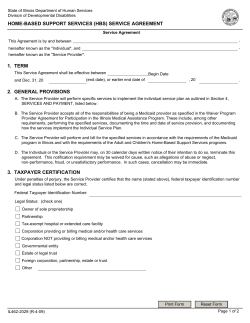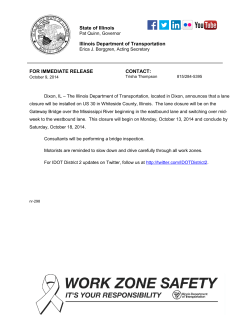
AAPT IOLab Status Talk - IOLab Wireless Lab System
IOLab: Status & Outlook Mats Selen (Tim Stelzer), University of Illinois Interactive Online Labs The Big Idea: Each student has their own wireless device (buy cheap). They are guided through each ac/vity by interac/ve so4ware. Timing of ac/vi/es driven by pedagogy, not space/budget. Not just a simulation… Wireless DAQ hardware 1 Magnetometer 2.4 GHz Radio Microphone Buzzer Light Intensity Accelerometer Gyroscope Expansion Connectors Temperature 6 x Analog in 1 x DAC out 6 x Digital I/O/PWM Hi-‐Gain Amp FTDI Header (Vbat, V3.3, gnd) Atmospheric Pressure Wheel Encoder (y,vy,ay) Force Probe (±Fy) Manufacturing cost: Parts & labor < $45 (numbers depends on quan/ty) 2 Let’s Play! • Wheel, Force, Accel – Kinema/cs, Fdt = dP – Hooke's Law – SHM, F = ma • Gyro, Accel, Magnetometer, Voltage – SHM, centripetal & tangen/al accelera/on – Ωy vs emf • Sound & Light – FFT – Doppler 3 Status • Built 300 devices with research funds – About 260 of these have been loaned to around 30 collaborators (see next few slides). • Manufacturing 500 more test units now (expect first units from China this week). • Should have 3000 available for sale by fall 2015 – Price probably around $100 (set by Macmillan) 4 Fall 2014 IOLab Class Tests (Example University related projects) • 35 units used in “Take Home” semng at UIUC (volunteer students from Phys-‐211). – Content & assessment via smartPhysics (Ka/e Ansell). • 33 units used in “Studio” semng at UMass Amherst. – Con/nuing this spring (Heath Hatch). • 25 units used lab semng at Millikin University – Con/nuing this spring (Eric Martell). • 10 units used in preliminary study at Chemeketa Community College (w/ Portland State University). Show results 5 Chemeketa Community College (Preliminary Study by Erik Bodegom @PSU & colleagues) • 22 students did a kinema/cs module borrowed from David Sokolov’s RTP Mechanics Lab 1 (kinema/cs). – 7 students worked alone, 15 worked in groups or 2 or 3. – 6 worked at home, 16 in lab room – 7 used Mac, 15 used Windows. Survey Results I enjoyed using the IOLab software I enjoyed using the IOLab device The IOLab device was easy to use The IOLab software was easy to use Windows installation The IOLab software was easy to install was cumbersome. This has been fixed. Strongly Agree Mean Likert Score Strongly Disagree 6 Chemeketa Community College (Preliminary Study by Erik Bodegom @PSU & colleagues) • Students, on average, reported that they felt they learned more with this style of instruc/on. • Student comments were posi/ve: “I enjoyed using the IOLab device . . . I felt like it was beneficial to be able to create your own graphs by making your own motion with the device.” “To be honest, I simply find the whole concept of the IOLab to be very cool . . . I found this experience to be quite different than any similar labs I have ever done, and surprisingly fun!” “I enjoyed using this device. Working with a partner . . . we had a couple disputes on how to answer some of the questions so we used the device to determine the actual answer.” 7 Fall 2014 IOLab Class Tests (Example High School related projects) • 12 units used in teacher PD program at UIUC – Con/nuing program (Morten Lundsgaard). • 7 units used in teacher training program at UT Aus/n – Con/nuing program (Michael Marder). • 18 units used in Mahomet-‐Seymour High School Physics – Used for in-‐class lab ac/vi/es (Eric Poqer). • 20 units used in Wilmington High School Physics – Used for take-‐home design projects (Chris Cunnings). Show results 8 Wilmington High School (Preliminary Study) • Teacher developing “Flipped-‐IOLab Physics Curriculum” as part of his PhD research. • Using IOLab in class as well as for take-‐home projects. Example student-designed projects: So4ball swing video (show) Dog accelera/on video Car accelera/on video 9 Wilmington High School (Preliminary Study) • Used FCI to assess student gain for two semesters so far: – Fall 2013 – before implemen/ng Flipped-‐IOLab curriculum – Fall 2014 – a4er implementa/on of Flipped-‐IOLab curriculum • Fall 2013 (N=23, before Flipped-‐IOLab) – <pre> = 23.5, <post> = 38.2, Normalized Gain <g> = 0.197 • Fall 2014 (N=31, a4er Flipped-‐IOLab) – <pre> = 23.4, <post> = 58.0, Normalized Gain <g> = 0.459 For more information please contact Chris Cunnings: cunning7@illinois.edu 10 New IOLab Collabora/ons for 2015 • Duke University (Ying Wu, Robert Brown, Ken McKenzie): Using 20 devices for studio learning in Physics 141. • University of North Carolina at Greensboro (Ian Beaqy): Using 30 devices as part of a conversion of their introductory calculus base sequence to studio format. • Uppsala University (Cedric Linder, Filip Heijkenskjöld): Using 8 devices as to inves/gate the poten/al impact of IOLab on introductory physics in Sweden. • University of the Western Cape (Trevor Volkwyn, Eugenia Etkina, Gorazd Planinšič, Cedric Linder, Mats Selen) Studying the impact of ISLE inspired IOLab ac/vi/es on highly disadvantaged students in South Africa. 11 ISLE + IOLab Development Eugenia Etkina (Rutgers), Gorazd Planinšič (Ljubljana), Ka/e Ansell, Mats Selen, Tim Stelzer (Illinois). • ISLE is a well established research validated approach. Can IOLab be used to spread this successful pedagogy more broadly? • We will collaborate to create & disseminate a collec/on of IOLab ac/vi/es based on the ISLE philosophy. • We will implement and study this approach in the introductory physics sequence at the University of Illinois. • The ISLE + IOLab approach was tested successfully at a recent workshop at Uppsala University. 12 Stay tuned • The first 500 devices from the new manufacturer are arriving this month. – Email mats@illinois.edu if you want to try some. • We expect that there will be at least 3000 devices available for sale for Fall 2015. • IOLab is a great tool, though don’t forget that the key to learning will be the pedagogy and the content that it enables. – Just like clickers. 13
© Copyright 2025



















